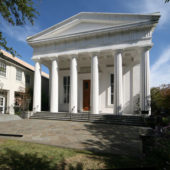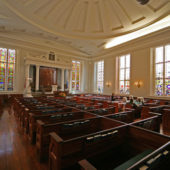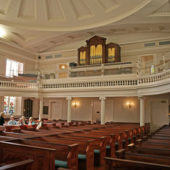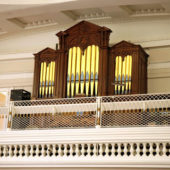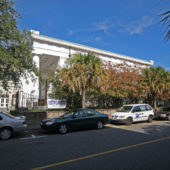America’s first Reform Jewish Congregation
Kahal Kadosh Beth Elohim (translated as Holy Congregation House of God and called “KKBE” for short) is the fourth oldest synagogue in the United States. In 1749, Charleston, South Carolina had grown to have enough pioneer Jews in the area who wanted to meet together. Thus, they formed KKBE and fifteen years later, bought land and founded the historic Coming Street Cemetery. This cemetery today is the oldest Jewish cemetery in the South.
Initially, services took place at a congregant’s home and subsequently, from 1775, in a makeshift structure next to the present grounds. In 1790 George Washington replied to a letter from KKBE congratulating him on his presidency, saying: “The affectionate expressions of your address again excite my gratitude, and receive my warmest acknowledgement. May the same temporal and eternal blessing which you implore for me, rest upon your Congregation.” In 1792 the undertaking of the largest and most stunning synagogue yet to be built in the country began and it was dedicated as Kahal Kadosh Beth Elohim, two years hence. Unfortunately, it was consumed in the fire of 1863, but rebuilt by 1840 on Hassell Street, on the same site KKBE uses today. The colonnaded synagogue was dedicated in 1841. Today, as when constructed, it is an exceptional example of Greek Revivalist Architecture that it is so well-known for today. Today, KKBE is the second oldest synagogue in the United States and the oldest in continuous use. In 1980 it was designated a National Historic Landmark.
The stunning Greek Revivalist structure was constructed by congregant David Lopez in 1840, and designed by architects Tappan and Noble, with work plans by C.L. Warner. An elegant iron fence from 1794 adorns the front of the property. The bases of two menorahs (candelabras) are also original from the construction of the Synagogue, and are placed on each side of the bimah. Stained glass windows with Jewish symbols adorn the walls. They are dated 1886 because, due to an earthquake earlier that year, the originals had to be replaced. The imposing Ark, made of Santo Domingo mahogany, houses the four Torah scrolls. Above the large entrance doors is a huge marble tablet, which in Hebrew proclaims the Sh’ma, “Hear O Isreal the Lord Our God is the sole eternal being.” Additional buildings, Pearlstine Family Building and the Heyman Building, house the religious school, administrative offices, gift shop, social hall, kitchen, youth lounge, and supplemental meeting and classrooms.
Reform Judaism is known to have first come from Hamburg, Germany. It then swept into The United States, by way of Charleston, South Carolina. In 1824 congregants in the United States petitioned for English translation of the Hebrew, change in the Sephardic Orthodox liturgy, change of the Hebrew ritual, and a sermon in English; however, their request was denied. Disappointed liberal members resigned from the Sephardic Orthodox congregation and joined “The Reformed Society of Israelites.” This congregation lasted only 9 years, but has influenced much of Reform Judaism today. KBBE was one of the first synagogues of the Union of American Hebrew Congregations in 1873 (now Union for Reform Judaism URJ), and remains a Reform congregation today.
KBBE remains a vibrant, Reform Synagogue, involved with its congregation of over 475 families. It is proud to have played a vital part in both Jewish and American history.

